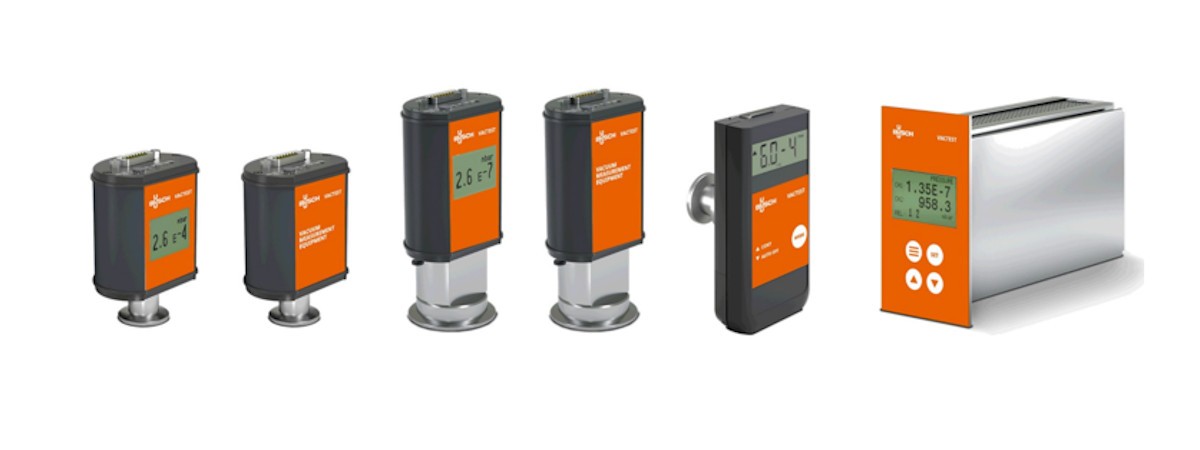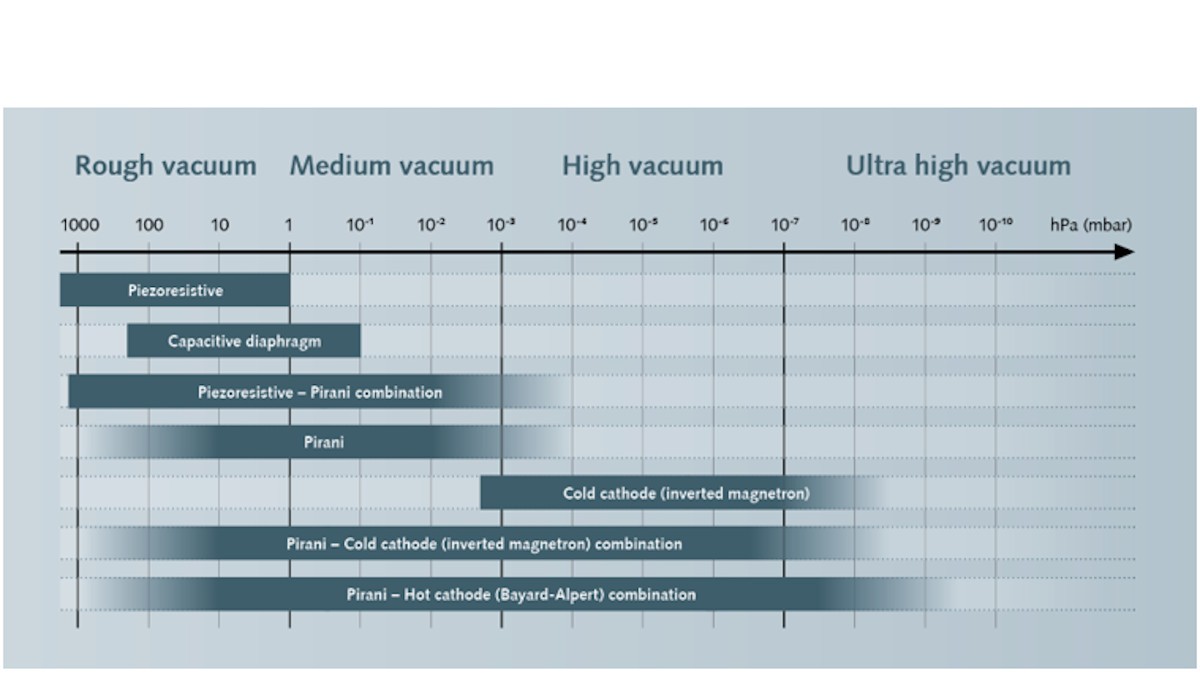Busch Vacuum Solutions has launched the new series of VACTEST vacuum measurement equipment.

Fig. 1: VACTEST analog and digital transmitters for various pressure ranges, as well as a VACTEST mobile gauge which is also available in several versions for different pressure ranges. Source: Busch Vacuum Solutions.
Vacuum measurement technology – reconsidered
VACTEST
The exact observance of pressures or pressure curves in vacuum-assisted processes in process engineering is an important parameter for ensuring optimum efficiency and the best product quality.
Busch Vacuum Solutions has now launched the new series of VACTEST vacuum measurement equipment. Designed to combine the latest advances in vacuum metrology with exceptional manufacturing quality, it provides an innovative and comprehensive portfolio of active vacuum gauges and controllers. Robust construction, reliability and measurement accuracy are key features of these devices, making them the ideal choice to monitor and control vacuum processes. State-of-the-art technologies allow for a wide measuring range from 1,600 to 5 · 10-10 mbar covering all vacuum levels with accuracy. All sensors comply with international standards and regulations such as CE and RoHS.
With the VACTEST vacuum metrology, Busch provides numerous sensor technologies to cover all decades of vacuum (Fig. 2). They can basically be divided into two main categories: direct and indirect pressure measurement.
-

Fig. 2: Areas of application of the various sensors. Source: Busch Vacuum Solutions.
The direct measuring principle is independent of the process gas and is based on the pressure that the molecular flow exerts on a membrane. This method is mainly used for rough and medium vacuum processes.
At a higher vacuum level, indirect measuring principles based on special properties of the process gas, such as thermal conductivity or ionization probability, are used. Unlike the direct measurement method, these principles depend on the type of process gas. For this reason, a specific correction factor must be applied for each process gas except air or nitrogen.
A number of factors must be taken into account when selecting the correct sensor. Knowledge of the pressure range, the required accuracy, the gas composition as well as the process and ambient conditions are of great importance for optimum measurement results. The VACTEST vacuum metrology comprises the following sensor technologies for direct pressure measurement independent of the gas type:
At a higher vacuum level, indirect measuring principles based on special properties of the process gas, such as thermal conductivity or ionization probability, are used. Unlike the direct measurement method, these principles depend on the type of process gas. For this reason, a specific correction factor must be applied for each process gas except air or nitrogen.
A number of factors must be taken into account when selecting the correct sensor. Knowledge of the pressure range, the required accuracy, the gas composition as well as the process and ambient conditions are of great importance for optimum measurement results. The VACTEST vacuum metrology comprises the following sensor technologies for direct pressure measurement independent of the gas type:
Piezoresistive sensor
The robust and cost-effective piezoresistive sensor technology measures the change in resistance of a strain gauge resulting from the diaphragm deflection. The robustness and versatility of the sensor means that it is the best choice for absolute pressure measurement in the rough vacuum range. The measuring range is between 1,600 and 1 millibars.
Capacitive sensor
Capacitive sensors exhibit a high degree of accuracy and measure the changes in the electrical capacitance of a plate condenser caused by the diaphragm displacement. These high resolution sensors are specially designed for industrial applications requiring high accuracy and chemical compatibility. Capacitive sensors can be used in the range from 200 to 0.1 millibars.The following sensor technologies are available for gas type-dependent indirect pressure measurement:
Pirani
The robust and reliable Pirani technology measures the thermal conductivity of gases. The heat transfer between a heated filament and its environment changes proportionally to the pressure. Pirani sensors are the best solution for medium vacuum applications.Pirani sensors can be used reliably in a wide measuring range from 1,000 to 1 · 10-4 millibars.
Cold cathode
The cost-effective and robust cold cathodes (inverted magnetron) measure the electrical conductivity of a plasma. Neutral gas molecules are ionized by collision with electrons and captured by the cathode. The current generated is an indication of the pressure in high and ultra-high vacuum processes. Cold cathodes can be used in the range from 2 · 10-3 to 5 · 10-9.In combination with Pirani sensors, they cover measuring ranges from 1,000 to 5 · 10-9 millibars.
Hot cathode
Hot cathodes based on the Bayard-Alpert principle measure gas ionization stably and reproducibly via thermal electron emission. The ion collector current is linear to the gas pressure. This technology forms one of the most accurate measuring principles for high and ultra-high vacuum. Together with a Pirani sensor, the measuring range is extended from 1,000 to 5 · 10-10 millibars.With the various VACTEST products, Busch meets all requirements for the measurement of pressures of a vacuum system or process in terms of accuracy, measurement range and functionality.
VACTEST analog transmitters have a compact, robust and functional design. Thanks to their excellent measurement accuracy and stability, these transmitters are the ideal solution for centralized monitoring and control systems.
VACTEST digital transmitters are high-end gauges with a full range of options as standard. Their intelligent microcontroller architecture provides optimum sensor control and various adjustment options, making it the ideal solution for a variety of applications. VACTEST digital transmitters work with Pirani sensor technology, cold cathode sensor technology or with Pirani/cold cathode or Pirani/hot cathode combinations.
VACTEST mobile gauges are the perfect hand-held solution for quality assurance of vacuum process maintenance. These battery-powered gauges offer many functions, such as a USB interface for exporting and displaying data as well as a data logger and can even be used under vacuum.
Busch Vacuum Solutions offers the VACTEST explorer as a software tool to provide fast and efficient visualization, analysis and comparison of process data on a computer or tablet.
VACTEST explorer is available in a Lite and a Pro version and includes numerous functions, for example calculation of leakage rates, Active Sensor Controller remote control, pump-down curve comparison, configuration of all digital transmitter parameters and many more.
The VACTEST viewer is a free Bluetooth monitoring application for mobile devices with an Android operating system, and can display the pressure values of up to 16 connected sensors. The tool was designed for Bluetooth data exchange between software and sensors and is ideally suited for maintenance or calibration purposes. Visual and audible alarms can be preset for maximum and minimum pressure values.
VACTEST mobile gauges are the perfect hand-held solution for quality assurance of vacuum process maintenance. These battery-powered gauges offer many functions, such as a USB interface for exporting and displaying data as well as a data logger and can even be used under vacuum.
Busch Vacuum Solutions offers the VACTEST explorer as a software tool to provide fast and efficient visualization, analysis and comparison of process data on a computer or tablet.
VACTEST explorer is available in a Lite and a Pro version and includes numerous functions, for example calculation of leakage rates, Active Sensor Controller remote control, pump-down curve comparison, configuration of all digital transmitter parameters and many more.
The VACTEST viewer is a free Bluetooth monitoring application for mobile devices with an Android operating system, and can display the pressure values of up to 16 connected sensors. The tool was designed for Bluetooth data exchange between software and sensors and is ideally suited for maintenance or calibration purposes. Visual and audible alarms can be preset for maximum and minimum pressure values.